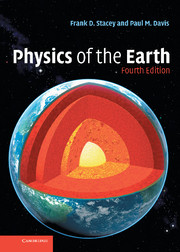Book contents
- Frontmatter
- Contents
- Preface
- 1 Origin and history of the Solar System
- 2 Composition of the Earth
- 3 Radioactivity, isotopes and dating
- 4 Isotopic clues to the age and origin of the Solar System
- 5 Evidence of the Earth's evolutionary history
- 6 Rotation, figure of the Earth and gravity
- 7 Precession, wobble and rotational irregularities
- 8 Tides and the evolution of the lunar orbit
- 9 The satellite geoid, isostasy, post-glacial rebound and mantle viscosity
- 10 Elastic and inelastic properties
- 11 Deformation of the crust: rock mechanics
- 12 Tectonics
- 13 Convective and tectonic stresses
- 14 Kinematics of the earthquake process
- 15 Earthquake dynamics
- 16 Seismic wave propagation
- 17 Seismological determination of Earth structure
- 18 Finite strain and high-pressure equations of state
- 19 Thermal properties
- 20 The surface heat flux
- 21 The global energy budget
- 22 Thermodynamics of convection
- 23 Thermal history
- 24 The geomagnetic field
- 25 Rock magnetism and paleomagnetism
- 26 ‘Alternative’ energy sources and natural climate variations: some geophysical background
- Appendix A General reference data
- Appendix B Orbital dynamics (Kepler's laws)
- Appendix C Spherical harmonic functions
- Appendix D Relationships between elastic moduli of an isotropic solid
- Appendix E Thermodynamic parameters and derivative relationships
- Appendix F An Earth model: mechanical properties
- Appendix G A thermal model of the Earth
- Appendix H Radioactive isotopes
- Appendix I A geologic time scale
- Appendix J Problems
- References
- Name Index
- Subject Index
4 - Isotopic clues to the age and origin of the Solar System
Published online by Cambridge University Press: 05 July 2013
- Frontmatter
- Contents
- Preface
- 1 Origin and history of the Solar System
- 2 Composition of the Earth
- 3 Radioactivity, isotopes and dating
- 4 Isotopic clues to the age and origin of the Solar System
- 5 Evidence of the Earth's evolutionary history
- 6 Rotation, figure of the Earth and gravity
- 7 Precession, wobble and rotational irregularities
- 8 Tides and the evolution of the lunar orbit
- 9 The satellite geoid, isostasy, post-glacial rebound and mantle viscosity
- 10 Elastic and inelastic properties
- 11 Deformation of the crust: rock mechanics
- 12 Tectonics
- 13 Convective and tectonic stresses
- 14 Kinematics of the earthquake process
- 15 Earthquake dynamics
- 16 Seismic wave propagation
- 17 Seismological determination of Earth structure
- 18 Finite strain and high-pressure equations of state
- 19 Thermal properties
- 20 The surface heat flux
- 21 The global energy budget
- 22 Thermodynamics of convection
- 23 Thermal history
- 24 The geomagnetic field
- 25 Rock magnetism and paleomagnetism
- 26 ‘Alternative’ energy sources and natural climate variations: some geophysical background
- Appendix A General reference data
- Appendix B Orbital dynamics (Kepler's laws)
- Appendix C Spherical harmonic functions
- Appendix D Relationships between elastic moduli of an isotropic solid
- Appendix E Thermodynamic parameters and derivative relationships
- Appendix F An Earth model: mechanical properties
- Appendix G A thermal model of the Earth
- Appendix H Radioactive isotopes
- Appendix I A geologic time scale
- Appendix J Problems
- References
- Name Index
- Subject Index
Summary
Preamble
The notion that the Earth and Sun had a common origin has a long history, predating by many years modern ideas about their ages. It underlay the paradox that paralyzed geological thinking in the late 1800s: there was no known source of the Sun's energy that could warm the Earth for the apparent duration of the sedimentary record. The discovery of radioactivity by H. Becquerel in 1896 was deemed to release geological thinking from the conceptual difficulty of a very limited age for the Earth, although the release was not logically satisfying until thermonuclear fusion was recognized in the 1930s. Following the discovery of radioactivity, its two principal roles in studies of the Earth were promptly recognized. Measurements of radiogenic heat in igneous rocks, especially by Strutt (1906), and early ideas about dating, initiated by Rutherford, confirmed its significance. This chapter considers the global and Solar System questions that are illuminated by studies of isotopes; evidence for the evolution of the Earth is considered in the following chapter and radiogenic heat in Chapter 21.
Meteorites are especially important to our understanding of the early Solar System. Unlike the planets, they have suffered little modification since their common origin, 4.57 × 109 years ago. Isotopic studies on meteorites date the Solar System (Section 4.3); a precise independent age for the Earth cannot be obtained from terrestrial rocks, which have evolved in many ways from the original nebular mix.
- Type
- Chapter
- Information
- Physics of the Earth , pp. 61 - 71Publisher: Cambridge University PressPrint publication year: 2008



